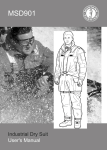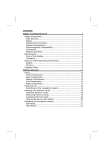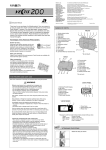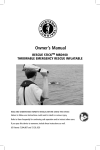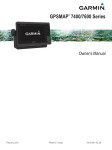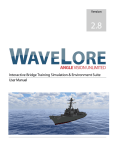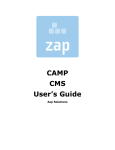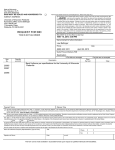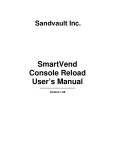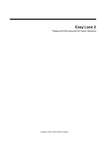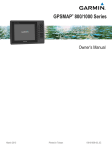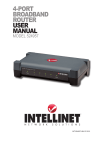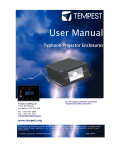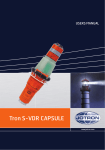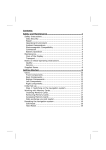Download TABLE OF CONTENTS - Mustang Survival
Transcript
MUSTANG SURVIVAL DAMAGE TOLERANT LIFE PRESERVER, MUSTANG MODELS MD4020/MD4025 FR DESCRIPTION AND MAINTENANCE INSTRUCTIONS MAY 11, 2007, REV: 1.1 MD4020 shown Mustang Survival Canada 3810 Jacombs Road Richmond, BC, V6V 1Y6 Tel: (604) 270-8631 Fax: (604) 270-0489 E-mail: mustang@mustangsurvival.com WEB: www.mustangsurvival.com Mustang Survival-USA 3870 Mustang Way Bellingham, WA USA 98226 Tel: (360) 676-1782 Fax: (360) 676-5014 E-mail: mustangusa@mustangsurvival.com Mustang Survival MD4020/MD4025 FR DTLP Description and Maintenance Instructions 11 May 2007, Rev: 1.1 TABLE OF CONTENTS 1.0 INTRODUCTION................................................................................................................. 1 1.1 1.2 1.3 1.4 GENERAL ..................................................................................................................................1 CONTACT ..................................................................................................................................1 RIGHTS RESERVED .................................................................................................................1 RESPONSIBILITIES...................................................................................................................1 2.0 FEATURES......................................................................................................................... 3 2.1 DESIGN AND CONSTRUCTION ...............................................................................................3 2.2 ASSEMBLED DTLP (MD4020 SHOWN)....................................................................................3 2.3 LIFE PRESERVER.....................................................................................................................5 2.4 INFLATABLE CELL ....................................................................................................................5 2.5 AUTOMATIC CO2 INFLATION DEVICE (MD4020)....................................................................7 2.6 MANUAL CO2 INFLATION DEVICE (MD4025 FR) ....................................................................7 2.7 BEADED CO2 INFLATION HANDLE..........................................................................................8 2.8 ORAL VALVE AND PRESSURE RELIEF VALVE......................................................................8 2.9 BALLISTIC CYLINDER POUCH ................................................................................................9 2.10 PROTECTIVE CONTAINER.......................................................................................................9 2.11 HARNESS SYSTEM...................................................................................................................9 3.0 OPERATION..................................................................................................................... 13 4.0 RE-ARMING ..................................................................................................................... 14 4.1 4.2 4.3 RE-ARMING THE MD4020 ONLY ...........................................................................................14 BALLISTIC CONTAINMENT POUCH (MA4050) INSTRUCTIONS (MD4025 FR ONLY) ........17 RE-ARMING THE MD4025 FR ONLY......................................................................................20 5.0 HARNESS CONFIGURATION.......................................................................................... 22 6.0 DONNING AND PACKING INSTRUCTIONS.................................................................... 25 6.1 6.2 6.3 GENERAL ................................................................................................................................25 ASSEMBLY, FOLDING AND PACKING INSTRUCTIONS ......................................................25 DONNING.................................................................................................................................35 7.0 MAINTENANCE AND CARE ............................................................................................ 37 7.1 7.2 7.3 7.4 7.5 7.6 7.7 7.8 GENERAL ................................................................................................................................37 CLEANING ...............................................................................................................................37 TREATMENT AFTER IMMERSION .........................................................................................37 SERVICE LIFE .........................................................................................................................38 WORK AREA............................................................................................................................38 STORAGE ................................................................................................................................38 EQUIPMENT REQUIRED ........................................................................................................38 MAINTENANCE REPORTING .................................................................................................38 8.0 INSPECTION AND TESTING ........................................................................................... 39 8.1 8.2 8.3 8.4 8.5 8.6 8.7 8.8 REQUIREMENTS.....................................................................................................................39 PRE-USE AND POST-USE INSPECTION...............................................................................39 VISUAL INSPECTION..............................................................................................................39 MAINTENANCE INSPECTION ................................................................................................41 ORAL INFLATOR VALVE TEST ..............................................................................................41 RELIEF VALVE TEST ..............................................................................................................41 INFLATABLE CELL TEST........................................................................................................42 CO2 INFLATION DEVICE TEST ..............................................................................................42 i This document is for information purposes only. It is not a controlled document and may not be considered current when printed. Mustang Survival MD4020/MD4025 FR DTLP Description and Maintenance Instructions 11 May 2007, Rev: 1.1 8.9 CO2 CYLINDER INSPECTION AND WEIGHT TEST...............................................................43 9.0 REPAIRS .......................................................................................................................... 44 9.1 GENERAL ................................................................................................................................44 9.2 IDENTIFICATION OF DEFECTS .............................................................................................44 9.3 HARNESS OR PROTECTIVE CONTAINER............................................................................44 9.4 SEWING ...................................................................................................................................44 9.5 INFLATABLE CELL ..................................................................................................................47 9.6 LEAK LOCALIZATION .............................................................................................................47 9.7 PATCH GLUEING ....................................................................................................................47 9.8 CO2 INFLATION DEVICE.........................................................................................................48 9.9 RESTRAINT LAYER ................................................................................................................48 9.10 CO2 CYLINDER ........................................................................................................................48 10.0 11.0 11.2 11.3 11.4 11.5 11.6 SUMMARY ................................................................................................................. 49 PARTS LIST ............................................................................................................... 49 MA4050 BALLISTIC CONTAINMENT POUCH ........................................................................49 MA4012 FR EBS POCKET ASSEMBLY ..................................................................................49 MA4006 INTEGRATION STRAP..............................................................................................50 MA4013 RE-ARM KIT...............................................................................................................50 MA4014 RE-ARM KIT...............................................................................................................50 ii This document is for information purposes only. It is not a controlled document and may not be considered current when printed. Mustang Survival MD4020/MD4025 FR DTLP Description and Maintenance Instructions 11 May 2007, Rev: 1.1 TABLE OF FIGURES Figure 1. Component Locations (front view) ......................................................................................... 3 Figure 2. Tactical Vest Attachments ..................................................................................................... 4 Figure 3. Duty Belt with Upper Body Harness Configuration ................................................................ 4 Figure 4. Upper Body Harness Configuration ....................................................................................... 4 Figure 5. Component Locations (rear view).......................................................................................... 5 Figure 6. Inflatable Cell ......................................................................................................................... 6 Figure 7. Automatic/Manual CO2 Inflation Device – Non-Operated/Ready Position............................. 7 Figure 8. Manual CO2 Inflation Device.................................................................................................. 8 Figure 9. MA4050 Ballistic Cylinder Pouch........................................................................................... 9 Figure 10. MD4020 Harness System.................................................................................................... 10 Figure 11. Eight adjustment points ....................................................................................................... 10 Figure 12. DTLP Tactical Vest Front and Rear Attachment Points....................................................... 11 Figure 13. Side-release Buckles ........................................................................................................... 11 Figure 14. Accessory Strap Addition..................................................................................................... 12 Figure 15. Step a. Re-arming Your MD4020 ........................................................................................ 14 Figure 16. Step b. Re-arming Your MD4020 ........................................................................................ 14 Figure 17. Step c. Re-arming Your MD4020......................................................................................... 15 Figure 18. Step d. Re-arming Your MD4020 ........................................................................................ 15 Figure 19. Step e. Re-arming Your MD4020 ........................................................................................ 15 Figure 20. Step f. Re-arming Your MD4020 ......................................................................................... 16 Figure 21. Step g. Re-arming Your MD4020 ........................................................................................ 16 Figure 22. Step h. Re-arming Your MD4020 ........................................................................................ 16 Figure 23. Step i. Re-arming Your MD4020.......................................................................................... 17 Figure 24. Step a. Pouch Installation Instructions................................................................................. 17 Figure 25. Step b. Pouch Installation Instructions................................................................................. 18 Figure 26. Step c. Pouch Installation Instructions................................................................................. 18 Figure 27. Step d. Pouch Installation Instructions................................................................................. 19 Figure 28. Step e. Pouch Installation Instructions................................................................................. 19 Figure 29. Step f. Pouch Installation Instructions.................................................................................. 19 Figure 30. Step a. Re-arming Your MD4025 FR................................................................................... 20 Figure 31. Step b. Re-arming Your MD4025 FR................................................................................... 20 Figure 32. Step a. Harness Assembly and Mounting............................................................................ 22 Figure 33. Step b. Protective Cover Mounting Points ........................................................................... 22 Figure 34. Step c. Webbing and Snap Attachment System at the Collar ............................................. 23 Figure 35. Step d. Closure Sequence of the Webbing and Snap Attachment System ......................... 23 Figure 36. Step e. Webbing and Snap Attachment System at the Lobe............................................... 24 Figure 37. Step f. Webbing and Snap Attachment System at the Collar .............................................. 24 Figure 38. Step b. Evacuated Inflatable Cell (MD4025 FR Shown)...................................................... 25 Figure 39. Step c. Inflatable Cell Inversion Sequencing (Left to Right) ................................................ 26 Figure 40. Step d. Layout of the Half-Inflatable Cell Shapes ................................................................ 26 Figure 41. Step e. Placement of the Inflatable Cell into the Restraint Layer ........................................ 27 Figure 42. Step f. Mounting the Inflator Assembly ................................................................................ 27 Figure 43. Step h. Inflatable Cell Assembly (MD4020 shown).............................................................. 28 Figure 44. Step j. Layout and Packing Fold 1, Right Lobe.................................................................... 29 Figure 45. Step k. Packing Folds 2 and 3, Right Lobe.......................................................................... 29 Figure 46. Step l. Packing Folds 4 and 5, Right Lobe........................................................................... 30 Figure 47. Step m. Packing Fold 6, Right Lobe .................................................................................... 31 Figure 48. Step n. Zipper Tail Closure, Right Lobe............................................................................... 31 iii This document is for information purposes only. It is not a controlled document and may not be considered current when printed. Mustang Survival MD4020/MD4025 FR DTLP Description and Maintenance Instructions 11 May 2007, Rev: 1.1 Figure 49. Step o. Packing Folds 7, 8 and 9, Left Lobe........................................................................ 32 Figure 50. Step p. Packing Folds 10 and 11, Left Lobe........................................................................ 33 Figure 51. Step q. Packing Folds 15 and 16, Collar ............................................................................. 33 Figure 52. Step r. Packing Fold 17 and Zipper Closure........................................................................ 34 Figure 53. Step s. Zipper Finishing and Final Arming........................................................................... 35 Figure 54. Step y. Donning Closures and Adjustment Points ............................................................... 36 Figure 55. Step a. Patching .................................................................................................................. 45 Figure 56. Step b. Patching .................................................................................................................. 46 Figure 57. Steps c., d. and e. Patching................................................................................................. 46 Figure 58. Steps f. and g. Patching....................................................................................................... 47 Figure 59. MA4050 Ballistic Containment Pouch with Cover................................................................ 49 Figure 60. MA4012 FR Pocket Assembly ............................................................................................. 49 Figure 61. MA4006 Integration Strap.................................................................................................... 50 iv This document is for information purposes only. It is not a controlled document and may not be considered current when printed. Mustang Survival MD4020/MD4025 FR DTLP Description and Maintenance Instructions 11 May 2007, Rev: 1.1 1.0 INTRODUCTION 1.1 GENERAL 1.1.1 The MD4020 and MD4025 FR Damage Tolerant Life Preservers (DTLPs) are each comprised of a life preserver and mounting harness assembly. These devices are designed to operate in any scenario regardless of ballistic damage or penetration of a lobe. 1.1.2 The MD4020 is designed primarily for marine boarding parties that are performing tactical ship-boarding operations on a potentially hostile vessel. In the event of an accidental manoverboard or in the possible event of being struck by firearm discharge, this device automatically inflates and self rights an unconscious user (US Patent 6,452,840). 1.1.3 The MD4020 life preserver is universal in size and fit and uses an automatic inflator. The standard color is black and the materials are non-FR. 1.1.4 The MD4025 FR is primarily used by aviation aircrew and passengers in hostile operating environments. The MD4025 FR is configured with a manual inflator and in the event of an emergency egress or in the possible event of being struck by firearm discharge, this device self rights a conscious user when inflated (US Patent 6,452,840). 1.1.5 The olive drab, fire-retardant MD4025 FR conforms to Air Standard ASCC 61/102/18 requirements. The harness can be adjusted with the eight adjustment points to fit an individual. 1.2 CONTACT 1.2.1 For further information concerning this manual or the DTLP, contact: Mustang Survival Corp. 3810 Jacombs Road Richmond, BC, Canada V6V 1Y6 Tel. (604) 270-8631 Fax (604) 270-0489 E-mail: mustang@mustangsurvival.com WEB: www.mustangsurvival.com 1.3 RIGHTS RESERVED 1.3.1 Velcro is a trademark of American Velcro Inc. 1.4 RESPONSIBILITIES 1.4.1 The individual to whom the DTLP is issued or assigned, following internal training, assumes responsibility for pre and post use inspections and for returning the DTLP to the Maintenance Shop for periodic inspection and testing on required dates. 1 This document is for information purposes only. It is not a controlled document and may not be considered current when printed. Mustang Survival MD4020/MD4025 FR DTLP Description and Maintenance Instructions 11 May 2007, Rev: 1.1 1.4.2 Each operational organization is responsible for the instruction and survival training of all DTLP users in the following: a. Fitting and operation of the DTLP. b. Purpose, use and operation of all DTLP furnished equipment accessories. c. Importance and method of visual pre and post use inspections. 1.4.3 The Maintenance Shop is responsible for: a. Periodic inspection and testing of the DTLP. NOTE: The inspection interval should not exceed 180 days (see section 8.0). b. Inspection when first issued from a Supply Depot or contractor and prior to issue for service. c. Maintenance, cleaning, and repair if and when required. d. Ensuring that a fully charged carbon dioxide (CO2) cylinder, automatic bobbin and functional CO2 inflation device are properly installed prior to issue. e. Requisitioning and maintaining stocks of spare parts. f. 1.4.4 Maintenance of inspection records of all MD4020 and MD4025 FR units. Testing 1.4.4.1 All DTLPs are tested to ensure the highest level of reliability and performance. Mustang Survival offers superior quality under rigid QA standards which are certified to ISO-9001. 1.4.5 Fit 1.4.5.1 When a DTLP unit is initially issued to personnel, it is to be individually fitted to the wearer. The wearer is to be fully instructed in the donning and adjustment procedures. 2 This document is for information purposes only. It is not a controlled document and may not be considered current when printed. Mustang Survival MD4020/MD4025 FR DTLP Description and Maintenance Instructions 11 May 2007, Rev: 1.1 2.0 FEATURES 2.1 DESIGN AND CONSTRUCTION 2.1.1 General 2.1.1.1 Mustang Survival MD4020 and MD4025 FR DTLPs are designed to provide flotation in case of immersion in water, minimizing the risk of drowning. This DTLP inflates manually (MD4025 FR) or automatically (MD4020), upon water immersion. It is also designed to worn over top of body armour and in the event of direct ballistic penetration to one lobe, has a redundant system that will provide a fully functional life preserver. 2.1.1.2 The FR version (MD4025 FR) is made of fire retardant materials. 2.1.2 Familiarize yourself with all the features of the DTLP to maximize its effectiveness. Illustrations are provided to support the text. NOTE: All location reference points in this section are based from the perspective of the person wearing the DTLP. 2.2 ASSEMBLED DTLP (MD4020 SHOWN) Figure 1. Component Locations (front view) Protective Cover Harness Assembly Main Buckle Adjustment Points Thigh Strap Beaded Inflation Handles 3 This document is for information purposes only. It is not a controlled document and may not be considered current when printed. Mustang Survival MD4020/MD4025 FR DTLP Description and Maintenance Instructions 11 May 2007, Rev: 1.1 Figure 2. Tactical Vest Attachments Figure 3. Duty Belt with Upper Body Harness Configuration Figure 4. Upper Body Harness Configuration 4 This document is for information purposes only. It is not a controlled document and may not be considered current when printed. Mustang Survival MD4020/MD4025 FR DTLP Description and Maintenance Instructions 11 May 2007, Rev: 1.1 Figure 5. Component Locations (rear view) Protective Cover Attachment Points Velcro Tab Breakout Point Adjustment Points Thigh Strap 2.3 LIFE PRESERVER 2.3.1 The life preserver assembly consists of four major components: a. Inflatable Cells b. Restraint Layer c. Protective Container d. Harness Assembly 2.3.2 The life preserver cover is attached directly to the mounting harness assembly with an interlocking webbing and snap system at four points and is easily removable. Attached to the life preserver cover, also with an interlocking webbing and snap system at four points, is the inflatable cell restraint layer and associated inflatable cells. The four attachment points for both interfaces are at each lobe (right and left) and the collar (right and left). The inflatable cell, when folded and packed, is contained within the protective container by means of a perimeter zipper closure system (US Patent 6,832,415) and a Velcro patch located at the rear at the zipper ends at the rear collar. 2.4 INFLATABLE CELL 2.4.1 The inflatable cells are made from polyurethane coated nylon fabric. The perimeter of each cell is sealed using radio frequency (RF) bonding. 5 This document is for information purposes only. It is not a controlled document and may not be considered current when printed. Mustang Survival MD4020/MD4025 FR DTLP Description and Maintenance Instructions 11 May 2007, Rev: 1.1 Figure 6. Inflatable Cell Lifting Strap Reflective Tape Restraint Layer Buddy Line Sea Light MA4050 Ballistic Pouch for Cylinder Bladder Access Zipper Inflator Activation Lanyard Pressure Dump / Relief Valve Right Lobe 2.4.2 The life preserver comprises two discrete inflatable cells (or chambers, right and left, each of which operate independent of one another. Each inflatable cell is inverted on itself and placed into one half of the restraint layer (either right or left). When activated, the device will operate as a fully functional Personal Flotation Device (PFD) with either or both chambers deployed. If both chambers are deployed, either cell will inflate into either one another to fill the restraint layer. If only one of the two inflatable cells is activated, the cell will inflate into the opposite chamber (i.e.: the non-activated side) to fill the restraint layer (US Patent 6,452,840). Excess inflation gas is vented through a breather valve (or pressure relief/dump valve) on each chamber. WARNING: The MD4020 DTLP is configured with an automatic inflation system and will inflate when immersed in at least 4 inches (10 cm) of water. 2.4.3 Normal manual or automatic inflation by carbon dioxide gas (CO2) from a stored cylinder, fully inflates either chamber. Either chamber may be inflated by mouth, and provides for redundancy in an event one of the chambers is damaged, requires topping up, or fails to operate for any reason. Air can also be vented using the same valve to provide lower pressure cells for additional comfort or mobility. The dump valve (if included) provides for rapid deflation. 2.4.4 When inflated, the cell forms a yoke around the back of the user's neck, extending into two lobes down the user's chest. 2.4.5 A webbing and snap assembly is used to attach the components to one another. Webbing straps are flaked in and out of small 1” slots and doubled back on one another before being 6 This document is for information purposes only. It is not a controlled document and may not be considered current when printed. Mustang Survival MD4020/MD4025 FR DTLP Description and Maintenance Instructions 11 May 2007, Rev: 1.1 secured with a ‘pull-the-dot’ snap. This provides a secure anchor that prevents mobility or rotation about these attachment points. 2.4.6 The largest inflatable cell is designed to provide a minimum buoyant force of 29.5 kg (65 lb), when fully inflated with 60 grams of carbon dioxide (CO2) gas stored in a cylinder in ambient temperatures above 0° C (32° F). 2.5 AUTOMATIC CO2 INFLATION DEVICE (MD4020) 2.5.1 The MD4020 incorporates an automatically operated inflation device. The operating components of the automatic inflation device (Hammar Auto Inflator) shown in figure 7. 2.5.2 For the MD4020, there are two automatic inflation devices: one located on each inflatable cell. The inflation device for the left cell is located on the rear left lobe towards the body, and the inflation device for the right cell is located on the front of the right lobe (away from the body on the front side of the inflatable). The inflation device is secured with an inner and outer component which interfaces with either side of the sealing ring (RF welded to the bladder). A 60g carbon dioxide (CO2) cylinder is threaded into the inner portion of the inflation device. Hydrostatic pressure is applied to objects submerged in water. The hydrostatic inflator needs only to be submerged 4 inches (10 cm) for the hydrostatic pressure to open a pressure valve releasing a firing mechanism, automatically inflating the PFD. Inflating under hydrostatic pressure, the PFD will not inflate prematurely due to rain, humidity or water contact (the PFD can be inflated manually by pulling the activation cord). Easily view the inflator replacement date and inflator status through the safety inspection window - green indicates ready for use. See re-arm instructions in section 4.1. Figure 7. Automatic/Manual CO2 Inflation Device – Non-Operated/Ready Position 2.6 MANUAL CO2 INFLATION DEVICE (MD4025 FR) 2.6.1 The MD4025 FR incorporates a manually operated inflation device. The operating components of the automatic inflation device (Halkey-Roberts HD7714-9 6FManual Inflator). See re-arm instructions in section 4.2. 7 This document is for information purposes only. It is not a controlled document and may not be considered current when printed. Mustang Survival MD4020/MD4025 FR DTLP Description and Maintenance Instructions 11 May 2007, Rev: 1.1 Figure 8. Manual CO2 Inflation Device CO2 Cylinder Manual Inflator Lever in the Up and Ready Position Indicator Tab Lanyard Beaded Handle 2.7 BEADED CO2 INFLATION HANDLE 2.7.1 The beaded inflation handles are constructed of five black plastic beads threaded onto a loop of nylon webbing. The handles are attached with a lanyard to the operating levers of each CO2 inflation device and snapped to the lower side of each lobe of protective container. The beaded handle is designed to be easily visible and provide a positive grip for inflation of the preserver with cold, wet or gloved hands. 2.8 ORAL VALVE AND PRESSURE RELIEF VALVE 2.8.1 Two oral inflator valve and pressure relief valve assemblies are attached to the inflatable cells (one each cell). The assemblies are RF (Radio-Frequency) bonded to the inflatable cell. Each oral valve and pressure relief valve accesses a separate independent chamber. 2.8.2 The oral inflator located on the rear left lobe of the inflatable cell inflates/deflates the left chamber. This relief valve is used to regulate the pressure in the left lobe of life preserver or can be manually activated to dump the gas from the cell in an emergency. 2.8.3 The oral inflator located on the front right lobe of the inflatable cell inflates/deflates the right chamber. This relief valve is also used to regulate the pressure in the right lobe of the life preserver or can be manually activated to dump the gas from the cell in an emergency. 2.8.4 Both inflators also provide a means of "topping-up" the cell to compensate for normal leakage or under-inflation due to excessively cold temperatures. As well, these oral inflators provide a means for cell deflation, which may be necessary in the event when both cylinders are simultaneously inflated (either manually or automatically). The relief valve is designed to begin venting at pressures greater than 2.0 psi to ensure proper inflation to form and breakout of the protective container. The DTLP concept requires a higher dynamic working pressure during the inflation stages. 8 This document is for information purposes only. It is not a controlled document and may not be considered current when printed. Mustang Survival MD4020/MD4025 FR DTLP Description and Maintenance Instructions 11 May 2007, Rev: 1.1 2.9 BALLISTIC CYLINDER POUCH 2.9.1 The MD4025 FR offers CO2 cylinder containment (MA4050) (Patent Pending by Pacific Safety Products) in the event of ballistic penetration. If unprotected, ballistic impact to the cylinder can cause fragmentation or cause the cylinder to become a hazardous projectile itself. Figure 9. MA4050 Ballistic Cylinder Pouch 2.10 PROTECTIVE CONTAINER 2.10.1 The protective outer container is constructed of a durable black 420 denier rip-stop nylon (MD4020) or sage green 6oz/yd2 Nomex IIIA® aramid (MD4025). The container incorporates Mustang’s patented Secure-Zip™ closure system (US Patent 6,832,415). The zippered enclosure can be opened via the break-away point at the back of the collar. 2.10.2 The protective container is constructed of heavy black Cordura nylon cloth (MD4020) or sage green Nomex (MD4025 FR). It is attached directly to the harness assembly with a webbing and snap attachment system. The container houses the life preserver (i.e.: restraint layer and two inflatable cells contained therein), providing a compact protective enclosure that optimizes mobility and comfort in the undeployed configuration. 2.10.3 The restraint layer is attached directly to the inside of the protective container with a webbing and snap attachment system. The cell is neatly folded and packed within the container, which in turn is secured in the closed position with a system of slide fasteners, and a Velcro™ tab. The tail ends of the slide fastener tapes are protected by 'tucking' the tails into the lower openings of the secured container to finish the closure. 2.10.4 The container’s slide fastener closure is closed with separate sliders on each half of the container. The zippers are backed over the open zipper teeth and re-closed to secure the closure (US Patent 6,832,415). 2.10.5 The inflation handle lanyard passes through the hole in the container that accommodates the zipper tail at the bottom of each container lobe and is attached at the beaded handle by Velcro™. 2.11 HARNESS SYSTEM 2.11.1 The life preserver is intended to be secured to the user using the (black or green) harness system. The standard harness system consists of a light-weight full-body harness that covers the torso and thighs. The harness has four attachment points that secure the protective container (and life preserver) to the front (2) and back (2) of the torso section using a webbing 9 This document is for information purposes only. It is not a controlled document and may not be considered current when printed. Mustang Survival MD4020/MD4025 FR DTLP Description and Maintenance Instructions 11 May 2007, Rev: 1.1 and snap attachment system. The front attachment has two adjacent snaps on either attachment point to improve life preserver stability. The webbing on the harness crosses over the back, crosses over each hip, and runs around the waist and thighs of the user. The device is donned by opening and closing 3 side-release buckles: one at the waist and one at each thigh. Figure 10. MD4020 Harness System 2.11.2 There are 8 adjustment points on the harness system, both right and left for each: waist adjustment, back adjustment, hip adjustment and thigh adjustment. All adjustments should be made so that the harness and life preserver is snug on the body, but allows user flexibility and mobility. Elastic retainers are fit onto each adjustment webbing to secure excess strapping after the harness has been adjusted. The excess strapping can be flaked into the elastic retainers where significant lengths are left after adjustment. In addition to elastic retainers, there are Velcro tabs at the end of each strap which can also be used to retain the strap ends on the harness. The harness should be fit snug and secure to the body to ensure proper performance of the life preserver. Proper fit should be verified by testing the in-water performance of the deployed device. Figure 11. Eight adjustment points Waist Hip Back Thigh IMPORTANT: When properly donned, the smallest portion of the inflatable should be on top of the shoulder, in the neck area. The back collar should be off the neck and positioned down the back for optimum comfort. 10 This document is for information purposes only. It is not a controlled document and may not be considered current when printed. Mustang Survival MD4020/MD4025 FR DTLP Description and Maintenance Instructions 11 May 2007, Rev: 1.1 2.11.3 If the device is worn with a tactical webbing vest, the life preserver can be separated from the harness and affixed to such a vest using the webbing and snap attachment system. Excess strap length is left on the back collar snap and webbing assemblies to allow either snapping or tie closure for fit variability. CAUTION: The life preserver should not be worn on the inside of a ballistic vest to avoid secondary impact injuries. The device is designed to take damage and perform as required and should be configured on the outside of any tactical ensemble. 2.11.4 The DTLP may be attached to load carriage or tactical vests or law enforcement webbing and harness assemblies using the two side-by-side attachment points, on the front of each lobe and at the back of the LP (as shown). Figure 12. DTLP Tactical Vest Front and Rear Attachment Points 2.11.5 Four-point attachment accessory straps may use side-release buckles for quick reconfiguration. Figure 13. Side-release Buckles 2.11.6 Accessory straps may added to accommodate a law enforcement belt or attach to a tactical vest. 11 This document is for information purposes only. It is not a controlled document and may not be considered current when printed. Mustang Survival MD4020/MD4025 FR DTLP Description and Maintenance Instructions 11 May 2007, Rev: 1.1 Figure 14. Accessory Strap Addition 12 This document is for information purposes only. It is not a controlled document and may not be considered current when printed. Mustang Survival MD4020/MD4025 FR DTLP Description and Maintenance Instructions 11 May 2007, Rev: 1.1 3.0 OPERATION CAUTION: Relief Valve blockage can cause valve malfunction. Malfunction of both pressure relief valves will cause over-pressurization and will over-stress the inflatable cell. Both chambers of the cell must be completely evacuated of any residual air or carbon dioxide gas prior to CO2 inflation. 3.1.1 Manual operation of the life preserver is accomplished by grasping either or both beaded inflation handles located on the lower side of the protective container. Jerking sharply downwards rotates the operating lever of the CO2 inflation device, which in turn forces the piercing pin to puncture the neck of the CO2 cylinder and allow the compressed gas to flow into the inflatable cell. Only one of the inflation cells needs to be manually activated (either left or right, whichever is most accessible) for the life preserver to be operational. When the MD4020 comes in contact with the water, the un-deployed inflation cell will fire (but vent to atmosphere), unless configured manually. 3.1.2 Firing both cells simultaneously will also deploy the device and excess gas will be vented through the pressure relief valves. 3.1.3 The MD4020 can be configured manually if desired (consult Mustang Survival for this modification). Advantages to manual inflation are: minimized probability of inadvertent inflation, movement through “over-the-waist” water without inflation, and conservation of inflation cylinders. Disadvantages to manual inflation are: no automatic inflation for unconscious users, no automatic inflation for incapacitated users, and no automatic redundancy. The MD4025 FR has no automatic inflation capability and must be manually activated. 3.1.4 The pressure of the expanding gas forces the fasteners around the periphery of the protective container to separate, automatically opening the protective container and allowing the cell to reach its fully inflated shape. NOTE: Carbon dioxide gas does not remain in the life preserver indefinitely. Either of the oral inflator valves can be used as a means of compensating for normal cell leakage. The oral inflators are also provided as an emergency back up in the unlikely event that the CO2 inflation device fails. 13 This document is for information purposes only. It is not a controlled document and may not be considered current when printed. Mustang Survival MD4020/MD4025 FR DTLP Description and Maintenance Instructions 11 May 2007, Rev: 1.1 4.0 RE-ARMING 4.1 RE-ARMING THE MD4020 ONLY NOTE: Use a valid Mustang Survival re-arm kit (MA4013) for this procedure. Use of other re-arm kits may result in improper operation or failure to operate and will void the product’s warranty. a. In order to access the inflator system, partially open the cover by unzipping the closure (near the slider tucked into the end of the cover). After retrieving the zipper tail, the slider can be opened to mid-lobe height. Carefully open the cover and unfold the bladder. To avoid inadvertent inflation, detach the beaded handle while re-arming. Hold the CO2 cylinder through the fabric, using one hand (Fig. 15). Figure 15. Step a. Re-arming Your MD4020 b. Insert the metal key between the black locking ring and labeled yellow cap. Turn the key counter-clockwise (Fig. 16). Figure 16. Step b. Re-arming Your MD4020 Locking Ring Key c. Turn the black locking ring counter-clockwise and lift off the cap (yellow inflator operating head Fig. 17). Dispose of the used cap. 14 This document is for information purposes only. It is not a controlled document and may not be considered current when printed. Mustang Survival MD4020/MD4025 FR DTLP Description and Maintenance Instructions 11 May 2007, Rev: 1.1 Figure 17. Step c. Re-arming Your MD4020 Cap d. Squeeze the sealing ring to elongate and remove the inflator body through the sealing ring (Fig. 18). Figure 18. Step d. Re-arming Your MD4020 Red Indicator Inflator Body Sealing Ring e. Dispose of the used inflator body. Figure 19. Step e. Re-arming Your MD4020 Red Indicator Trash 15 This document is for information purposes only. It is not a controlled document and may not be considered current when printed. Mustang Survival MD4020/MD4025 FR DTLP Description and Maintenance Instructions 11 May 2007, Rev: 1.1 f. Check that the new inflator body indicator is green. Insert the new inflator body with CO2 cylinder pointing upward inside the Inflatable PFD (Fig. 20). Let the sealing ring rest on the adapter around the four lugs. Figure 20. Step f. Re-arming Your MD4020 Green Indicator Caution: Do not turn the center shaft g. Now check the new manual/automatic cap as follows (Fig. 21): 1. Is the single point status indicator showing green? 2. Is the expiry date OK? If YES is the answer to both questions, then proceed as follows. If the answer is NO to either question, get a new cap. Figure 21. Step g. Re-arming Your MD4020 Water Inlet Valve Single Point Indicator h. Hold the CO2 cylinder through the fabric of the Inflatable PFD (Fig. 22). Position the replacement cap with the water inlet valve pointing to the right and press firmly onto the inflator body and sealing ring (Fig. 22). Figure 22. Step h. Re-arming Your MD4020 16 This document is for information purposes only. It is not a controlled document and may not be considered current when printed. Mustang Survival MD4020/MD4025 FR DTLP Description and Maintenance Instructions 11 May 2007, Rev: 1.1 i. While pressing FIRMLY onto the inflator body, turn the BLACK locking ring clockwise into the locked position (Fig. 23). Pull on the cap to make sure it has locked onto the inflator body. Figure 23. Step i. Re-arming Your MD4020 Black Locking Ring j. Check: To see that the single point status indicator on the cap is green, the pull to inflate lanyard is present and that the locking ring is locked. 4.2 BALLISTIC CONTAINMENT POUCH (MA4050) INSTRUCTIONS (MD4025 FR ONLY) 4.2.1 The Ballistic Containment Pouch instructions are for use with Mustang Survival Inflatable PFDs with Halkey-Roberts 6F inflators (manual or automatic). NOTE: Use with other manufacturer’s PFDs may result in improper operation or failure to operate and will void the product’s warranty. 4.2.2 Pouch Installation Instructions a. Gather an unused Ballistic Containment Pouch (MA4050) and Inflatable PFD (without cylinder). Note the parts displayed in the illustration. Remove any parts from the inflator post for pouch installation. NOTE: The inflatable cell shown in the following section is not the same as the MD4020 or MD4025 FR. However, it is adequate for this instruction. Figure 24. Step a. Pouch Installation Instructions b. Center the hole on the Ballistic Containment Pouch tether strap over the inflator post to ensure it does not interfere with the sealing surface (interface between the gasket and the inflator) when inflator is attached. Now place the bottom (thicker) gasket, inflator body 17 This document is for information purposes only. It is not a controlled document and may not be considered current when printed. Mustang Survival MD4020/MD4025 FR DTLP Description and Maintenance Instructions 11 May 2007, Rev: 1.1 and top gasket over the inflator post. Screw the inflator cap nut onto the post using a torque wrench to 30 lb-in. CAUTION: Incorrect placement can cause PFD malfunction. Figure 25. Step b. Pouch Installation Instructions c. Insert the new unused cylinder into the inflator through the main pouch opening (threaded end first). Slide the pouch down to expose the cylinder. Rotate the cylinder clockwise to a tight fit into the inflator. Manipulate the cylinder towards the centre of the pouch so it is securely held in the cup area. Replace bobbin and/or arming pin as required. Figure 26. Step c. Pouch Installation Instructions d. Fold the Ballistic Containment Pouch out flat. 18 This document is for information purposes only. It is not a controlled document and may not be considered current when printed. Mustang Survival MD4020/MD4025 FR DTLP Description and Maintenance Instructions 11 May 2007, Rev: 1.1 Figure 27. Step d. Pouch Installation Instructions e. Fold the Ballistic Containment Pouch to form a zig-zag pattern around the cylinder (end view). Figure 28. Step e. Pouch Installation Instructions f. Once folded, pinch the ends of the folded Ballistic Containment Pouch and cylinder and insert into the black nylon cover. Leave the tether strap outside of nylon pouch. Figure 29. Step f. Pouch Installation Instructions g. Repack the PFD using the instructions found in RE-ARMING THE MD4025 FR ONLY. 19 This document is for information purposes only. It is not a controlled document and may not be considered current when printed. Mustang Survival MD4020/MD4025 FR DTLP Description and Maintenance Instructions 11 May 2007, Rev: 1.1 4.3 RE-ARMING THE MD4025 FR ONLY i. Each automatic inflator assembly requires arming prior to packing. ii. A CO2 cylinder and green indicator pin are required for replacement, re-arm kit MA4014. iii. See the BALLISTIC CONTAINMENT POUCH (MA4050) I, if required, before proceeding. NOTE: Use a valid Mustang Survival re-arm kit (MA4014) for this procedure. Use of other re-arm kits may result in improper operation or failure to operate and will void the product’s warranty. a. To re-arm your Inflatable PFD, simply unscrew and discard the used CO2 cylinder (Fig. 30). In order to access the inflator system, partially open the cover by unzipping the closure (near the slider tucked into the end of the cover). After retrieving the zipper tail, the slider can be opened to mid-lobe height. Carefully open the cover and unfold the bladder. To avoid inadvertent inflation, detach the beaded handle while re-arming. Figure 30. Step a. Re-arming Your MD4025 FR b. To check that the inflator is fully operational, remove the indicator tab and pull down on the lanyard and see if the piercing pin travels freely. Both the head and lever should easily return to their original position (Fig. 31). Figure 31. Step b. Re-arming Your MD4025 FR Piercing Pin Indicator Tab Pull Down c. After using your Inflatable PFD, always rinse it with tap water to remove dirt and salt. Let dry before re-arming. d. Remove the cap nut. e. Remove the upper sealing gasket and CO2 inflation device by lifting it off the inflation manifold valve. f. Inspect the lower sealing gasket (still on manifold valve) and upper sealing gasket. If defective, deteriorated or cracked, replace with a new gasket. g. Remove and replace the core valve, if necessary. 20 This document is for information purposes only. It is not a controlled document and may not be considered current when printed. Mustang Survival MD4020/MD4025 FR DTLP Description and Maintenance Instructions 11 May 2007, Rev: 1.1 h. Reinstall the CO2 inflation device and upper gasket. Ensure that the MA4050 Ballistic Pouch does not compromise the gasket seal, if applicable. i. Install a cap nut and tighten to a torque of 8.0 inch-pounds using a calibrated torque wrench. j. With the manual lever in the up-and-ready position install the indicator tab into the inflator. Screw the new CO2 cylinder hand-tight into the inflator (Fig.31). Do not over tighten as this can damage the internal gasket. k. Refold the PFD according to the repacking instructions (see section 6.2). l. Repeat the same process for the inflator assembly on the opposite lobe. The left lobe inflator assembly will be on the back side of the inflatable cell assembly restraint layer and will be facing the work table. m. Perform the CO2 Inflation Device Test outlined in section 8.8. CAUTION: Once the device is armed, be careful not to accidentally pull or snag one of the inflation lanyards or the device may fire and inflate. 21 This document is for information purposes only. It is not a controlled document and may not be considered current when printed. Mustang Survival MD4020/MD4025 FR DTLP Description and Maintenance Instructions 11 May 2007, Rev: 1.1 5.0 HARNESS CONFIGURATION 5.1 Once the inflatable cells and restraint layer have been assembled, they can be attached to the other components of the life preserver. a. Beginning with the harness, lay the unassembled unit flat out onto the work space, with the back facing the work table. If the protective cover and inflatable cell assembly are already assembled to the harness, then skip to Step a (Figure 32) and proceed with packing the life preserver. Figure 32. Step a. Harness Assembly and Mounting Harness NOTE: If the harness assembly has not been disassembled, proceed to step m. b. Using the four mounting points (2 on the back and 2 on the front waist belt), assemble the protective cover to the harness assembly. Ensure that the webbing is oriented correctly prior to assembly, as shown in Figure 33. The back mounting points are folded forward to attach to the back of the collar. The right and left lobe each have 2 discreet webbing and snap assemblies at their respective mounting points to prevent inflatable cell rotation when in the water. Figure 33. Step b. Protective Cover Mounting Points Mounting Points c. All attachment points are typical and are referred to as “webbing and snap attachment systems”. They consist of flaking a webbing strap in and out of small webbing passthroughs and securing with a “pull-the-dot” snap fastener for secure mounting (see Figure 34). The pass-through on each respective sub-assembly runs adjacent to one another to make a continuous tunnel for the webbing strap. 22 This document is for information purposes only. It is not a controlled document and may not be considered current when printed. Mustang Survival MD4020/MD4025 FR DTLP Description and Maintenance Instructions 11 May 2007, Rev: 1.1 Figure 34. Step c. Webbing and Snap Attachment System at the Collar “Pull-the-Dot” Snap Fastener d. The strap mounted on the protective cover is fed through the harness assembly’s passthrough. It is then fed through the protective cover’s passed-through, effectively “lacing” the two bodies together. The webbing is then turned over the second pass-through loop and attached to the “pull-the-dot” snap socket mounted on the assembly. Once the snap dome is secured, the excess webbing can be tucked back into the loop assembly. If the excess webbing is atypically long, it can be re-flaked until all excess lengths have been secured. Repeat the same process for both mounting points on the back collar. NOTE: The first pass-through or loop that the webbing strap passes through is always on the opposite device that the strap is mounted on. For example, if the strap is mounted onto the protective cover, then the first pass-through is on the respective harness loop being mounted to. Figure 35. Step d. Closure Sequence of the Webbing and Snap Attachment System e. The protective cover’s lobes are mounted to the back collar similarly (as illustrated in Step d, Figure 35), except there are two adjacent webbing and snap attachment assemblies on each lobe. Each step must be simultaneously performed on each of the adjacent straps in order to complete both assemblies. Repeat the same process for both mounting points on the opposite lobe. WARNING: Failure to close both snap and webbing assemblies on each lobe may result in malfunction of the life preserver by improper flotation performance. 23 This document is for information purposes only. It is not a controlled document and may not be considered current when printed. Mustang Survival MD4020/MD4025 FR DTLP Description and Maintenance Instructions 11 May 2007, Rev: 1.1 Figure 36. Step e. Webbing and Snap Attachment System at the Lobe “Pull-the-Dot” Snap Fasteners f. After the harness has been secured to the protective cover, the protective cover can then be secured to the inflatable cell assembly (restraint layer and inflatable cells). Using the four mounting points (2 on the back of the collar and 1 on each lobe), assemble the inflatable cell assembly and the protective cover (similar to the sequence illustrated in Step d, Figure 35). Repeat the same process for each discrete attachment point. Figure 37. Step f. Webbing and Snap Attachment System at the Collar Collar Mounting Points g. See section 2.11 for Harness Configuration information. 24 This document is for information purposes only. It is not a controlled document and may not be considered current when printed. Mustang Survival MD4020/MD4025 FR DTLP Description and Maintenance Instructions 11 May 2007, Rev: 1.1 6.0 DONNING AND PACKING INSTRUCTIONS 6.1 GENERAL WARNING: The MD4020 and MD4025 FR must be worn with all life preserver components fully assembled. The modules are not to be worn separately unless otherwise stated in this document. A loss of protection and wear resistance may result if worn improperly. 6.2 ASSEMBLY, FOLDING AND PACKING INSTRUCTIONS 6.2.1 To assembly, fold and pack the DTLP: NOTE: All location reference points in this section are based from the perspective of the person wearing the DTLP (i.e.: “right” is the wearer’s right side). NOTE: These instructions are illustrated from the life preserver when it is completely disassembled. Disassembly of the life preserver is performed by following the instructions in reverse order. a. Lay the DTLP and it’s sub-components out on a flat, clean surface. NOTE: If the DTLP has not been deployed, or one of the cells has not been deployed. Then the bladder does not need to be removed from the restraint layer. Proceed to step h. (for the undeployed bladder only). b. If the DTLP is fully assembled, remove the inflatable cells by unzipping the protective cover from the Velcro™ break-out tab at the back of the collar, removing the inflator lanyard tab, removing the automatic inflator assemblies (see Step f, Figure 42) and removing the inflatable cells from the restraint layer via the 3 inflatable cell access zippers. Beginning with the removed inflatable cells (both right and left), ensure that each cell chamber is completely evacuated prior to proceeding. Once all residual gas has been removed from the inflatable cell, lay the inflatable cell flat and pull all significant wrinkles out of the evacuated cell. If the cell has not been deployed it may still be in a half-packed orientation. If it is in the half-packed position, then skip to Step e (Figure 41) as the inflatable cell can be evacuated without fully flattening the device in it’s single-layer. Figure 38. Step b. Evacuated Inflatable Cell (MD4025 FR Shown) Oral Inflator Manifold Valve Access Zipper 25 This document is for information purposes only. It is not a controlled document and may not be considered current when printed. Mustang Survival MD4020/MD4025 FR DTLP Description and Maintenance Instructions 11 May 2007, Rev: 1.1 c. At the bottom lobe opposite to the inflator manifold and oral tube assembly begin to invert the inflatable cell on itself (this will be the left side of the right inflatable cell and vice-versa). Using the fingertips, grasp both sides of the inflatable cell wall at the bottom of the lobe and separate the inflatable cell walls under vacuum. As the bottom edge of the lobe is drawn inward, assist it further into the inflatable cell cavity by pushing with the tip of your fingers to begin the inversion of the inflatable cell on itself. Continue to invert the left lobe until it is completely pushed into the inner cavity of the right lobe. Flatten the lobe by ensuring that the left lobe is forced into the extremities of the right inflatable cell. Once the inflatable cell is flattened, the finished shape will be exactly half of the initial inflatable cell shape. Repeat the same process for the second inflatable cell. NOTE: Both inflatable cells are identical and only differ by how they are packed into the restraint layer. Each inflatable cell can be substituted for one another (i.e.: right for left, or vice-versa) as long as it passes inspection and testing criteria outlined in Section 8.0. CAUTION: Proper operation of the device depends on the proper packing sequence. Complete evacuation, flattening of the inflatable cell and careful folding will ensure proper deployment. Figure 39. Step c. Inflatable Cell Inversion Sequencing (Left to Right) d. Once both inflatable cells are inverted into half-inflatable cell shapes, they will be placed opposite each other to make up the left and right inflatable cells. The left inflatable cell will have the manifold and oral tube assemblies facing toward the work table, and the right inflatable cell will have these assemblies facing away from the table. Figure 40. Step d. Layout of the Half-Inflatable Cell Shapes Oral Inflator Right Inflatable Cell e. Beginning with the right inflatable cell, place one of the inflatable cells into the restraint layer through the right lobe access zipper. Feed the oral tube and inflator assemblies through the respective pass-throughs (on the right lobe, these should be on the top face of the restraint layer on the same side of the inflation system). Push the inflatable cell out 26 This document is for information purposes only. It is not a controlled document and may not be considered current when printed. Mustang Survival MD4020/MD4025 FR DTLP Description and Maintenance Instructions 11 May 2007, Rev: 1.1 to the seams of the restraint layer so that the entire assembly is flattened. Ensure that the top end of the inflatable cell is on the top side of the baffle in the collar section of the restraint layer. Repeat the same process for the second inflatable cell, except ensure that the tope end of the inflatable cell is on the bottom (or opposite) side of the baffle in the collar of the restraint layer. Close all 3 access zippers on the restraint layer. WARNING: Failure to place the inflatable cells on opposite sides of the separation baffle in the collar section of the restraint layer may result in malfunction of the life preserver by improper deployment of the inflatable cell. WARNING: Failure to close the access zippers on the restraint layer could result in malfunction or catastrophic failure of the life preserver by improper restraint. Figure 41. Step e. Placement of the Inflatable Cell into the Restraint Layer Restraint Layer Baffle f. For the MD4025 FR only. Once the access zippers have been closed on the restraint layer, the inflator assemblies can be re-mounted onto the manifold valve on each cell. Ensure that a new bottom gasket and top gasket are used if the existing components are old or show any degradation for proper sealing. Using a 9/16” calibrated torque wrench, install the cap nut and tighten to a torque of 8.0 inch-pounds measured. Repeat the same process for both inflator assemblies on each inflatable cell. Figure 42. Step f. Mounting the Inflator Assembly g. Proceed to the Harness Configuration section to ensure the harness is properly configured. h. Once the inflatable cell assembly has been attached to the protective cover and harness, the attachment of the major sub-components is complete and the device is 27 This document is for information purposes only. It is not a controlled document and may not be considered current when printed. Mustang Survival MD4020/MD4025 FR DTLP Description and Maintenance Instructions 11 May 2007, Rev: 1.1 ready for arming and packing. Ensure the buddy-line has been placed inside the protective cover. Lay the device out flat on the table. Figure 43. Step h. Inflatable Cell Assembly (MD4020 shown) NOTE: If the DTLP has not been deployed, or one of the cells has not been deployed, then the bladder does not need to be removed from the restraint layer. Proceed to step a. (for the undeployed bladder only). i. Ensure the device is properly armed, see section 4.0 for re-arming instructions. j. Once the inflators are armed the device is ready for folding. Begin the folding procedure with the right lobe. Fold 1 is made by folding the half of the lobe with the inflator back over the adjacent half of the lobe. The vertical fold line should be at the edge of the attachment point to the protective cover. 28 This document is for information purposes only. It is not a controlled document and may not be considered current when printed. Mustang Survival MD4020/MD4025 FR DTLP Description and Maintenance Instructions 11 May 2007, Rev: 1.1 NOTE: The entire folded assembly of each lobe is required to be contained within the footprint area of the back panel of the protective cover. Use this panel as a reference area when packing the life preserver. Figure 44. Step j. Layout and Packing Fold 1, Right Lobe Vertical Fold Line k. The second fold is made by flaking the tip of the lobe back over the first fold, then continue to fold in the same direction rolling the cylinder back over top inflatable cell assembly over the back panel of the protective cover. The inflator should be on top of the inflatable cell assembly at this point, and the left side of the right lobe should be folded and tucked in among vertical folds. Figure 45. Step k. Packing Folds 2 and 3, Right Lobe l. The fourth fold is made by folding the remaining right half of the right lobe over top of the cylinder assembly at the edge of the attachment point to the protective cover. The fifth fold then flakes the tip of the lobe back over the fourth fold. At this point, all vertical folds 29 This document is for information purposes only. It is not a controlled document and may not be considered current when printed. Mustang Survival MD4020/MD4025 FR DTLP Description and Maintenance Instructions 11 May 2007, Rev: 1.1 on the right lobe are complete and the packaged inflatable cell assembly should fit within the width of the back panel of the protective cover. Figure 46. Step l. Packing Folds 4 and 5, Right Lobe m. Using your thumbs to crease a horizontal fold at the base of the inflator assembly, fold the lower portion of the flaked inflatable cell assembly over top of the inflator assembly to make the sixth fold. The entire right lobe assembly should be folded over the back panel of the protective cover. Ensure that the lever and lanyard have a clear sweep and pull path toward the center of the life preserver prior to closing the protective cover zipper closure. Alternatively, fold at the dump valve (if equipped). WARNING: Failure to ensure that the lever and lanyard have a clear sweep and pull path toward the centre of the device may result in life preserver malfunction by failure to activate manually. 30 This document is for information purposes only. It is not a controlled document and may not be considered current when printed. Mustang Survival MD4020/MD4025 FR DTLP Description and Maintenance Instructions 11 May 2007, Rev: 1.1 Figure 47. Step m. Packing Fold 6, Right Lobe Clear Sweep for Lever Relief Valve n. The packed right lobe can now be closed into the protective cover. Feed the beaded inflation handle through the opening at the bottom lobe between the tail end of the perimeter zipper and the bottom corner of the cover. While trying to apply a free forearm or elbow on the packed lobe as to prevent unpacking, back the slider up the zipper closure teeth. Back the zipper off until it is near the middle or top of the right lobe portion to temporarily secure the packed contents of the lobe while packing the opposite lobe. CAUTION: When backing up the zipper, be sure not to catch the restraint layer in the teeth or slider to prevent tearing of the restraint layer. Use your finger to prevent snagging. Figure 48. Step n. Zipper Tail Closure, Right Lobe 31 This document is for information purposes only. It is not a controlled document and may not be considered current when printed. Mustang Survival MD4020/MD4025 FR DTLP Description and Maintenance Instructions 11 May 2007, Rev: 1.1 o. The left lobe is similar, but not identical to packing the right lobe. The seventh fold (first on the left lobe) is made by folding the half of the lobe with the inflator assembly over the other half. This vertical fold line should be at the edge of the attachment point to the protective cover. The eighth fold is then made by flaking the inflator assembly back over the previous fold, and the ninth fold is an additional flake of the tip of the lobe back over the fold prior to it. If done properly, the inflation assembly lever should swing into the center of the life preserver (MD4025 FR only). WARNING: Failure to ensure that the lever and lanyard have a clear sweep and pull path toward the centre of the device may result in life preserver malfunction by failure to activate manually. Figure 49. Step o. Packing Folds 7, 8 and 9, Left Lobe Vertical Fold Line p. The final folds on the left lobe are made by beginning with the tenth fold, which is made by folding the remaining left half of the left lobe over top of the cylinder assembly and inflatable cell assembly at the edge of the attachment point to the protective cover. The eleventh fold then flakes the tip of the lobe back over the tenth fold. At this point, all vertical folds on the left lobe are complete and the packaged inflatable cell assembly should fit within the width of the back panel of the protective cover. Then similar to Step m (Figure 47), using your thumbs to crease a horizontal fold at the base of the inflator assembly, fold the lower portion of the flaked inflatable cell assembly over top of the inflator assembly to make the twelfth fold. The entire left lobe assembly should be folded over the back panel of the protective cover. Ensure that the lever and lanyard have a clear sweep and pull path toward the center of the life preserver prior to closing the protective cover zipper closure. Alternatively, fold at the relief valve (if equipped). WARNING: Failure to ensure that the lever and lanyard have a clear sweep and pull path toward the centre of the device may result in life preserver malfunction by failure to activate manually. 32 This document is for information purposes only. It is not a controlled document and may not be considered current when printed. Mustang Survival MD4020/MD4025 FR DTLP Description and Maintenance Instructions 11 May 2007, Rev: 1.1 Figure 50. Step p. Packing Folds 10 and 11, Left Lobe Relief Valve q. Repeat Step n (Figure 48) for the left lobe. When the zipper is at the mid-point of the protective lobe at the end of this step, a temporary tie or elastic may be used to temporarily secure the left lobe package. Continue the zipper back up the tape through the narrow shoulder section ensuring that the bulk of the inflator assembly and associated inflatable cell assembly is in the lobe cavity of the protective cover. The narrow section of the inflatable cell assembly can be flake folded on itself twice (folds 13 and 14) as the zipper is backed over the narrow section. The collar section of the inflatable cell assembly is then folded into the remaining cavity (the majority of free space is near the middle back). The fifteenth fold is made by folding in vertically the left side of the collar from the continued flake in the narrow section. The sixteenth fold is made by then folding the back of the collar over the previous fold. Figure 51. Step q. Packing Folds 15 and 16, Collar 33 This document is for information purposes only. It is not a controlled document and may not be considered current when printed. Mustang Survival MD4020/MD4025 FR DTLP Description and Maintenance Instructions 11 May 2007, Rev: 1.1 r. Fold the last protruding corner over into the center of the collar area and back the zipper up until it hits the stop at the back center of the collar. The zipper can now be run back along the zipper tape to close the teeth together. As the zipper begins closure, secure the Velcro™ tab at the back of the collar to temporarily hold the end of the zipper closed to prevent it from prematurely opening prior to the completion of the pack. Figure 52. Step r. Packing Fold 17 and Zipper Closure s. Remove the temporary lobe tie or elastic and close the perimeter zipper along the entire edge of the protective container until it runs to the stop at the bottom of the lobe. Adjust the contents of the pack until it fits the container properly, taking care to readjust any hard points that may be against the user. Carefully pull the entire webbing assembly from the beaded handle out of the pass-through at the bottom of the lobe and secure it to the Velcro™ retainer at the bottom of the lobe. Tuck the excess zipper tail into the lanyard pass-through to complete the arming of the left inflatable cell assembly. Move to the right lobe and continue to pack the remainder of the assembly following from Step q (Figure 51) through Step s (Figure 53) for the right lobe. The life preserver is now completely armed and ready for use. 34 This document is for information purposes only. It is not a controlled document and may not be considered current when printed. Mustang Survival MD4020/MD4025 FR DTLP Description and Maintenance Instructions 11 May 2007, Rev: 1.1 CAUTION: Take care to unfasten the Velcro™ tab on the collar carefully and reattach it when the zipper is backed into the stop and closed from the collar section. Failure to do so can cause the protective cover zipper to open prematurely. Figure 53. Step s. Zipper Finishing and Final Arming 6.3 DONNING 6.3.1 Once the device is armed, it can be donned like a typical harness. The device is secured by 3 side-release buckles: one at the waist and one at each thigh. After these buckles have been fastened, there are 8 adjustment points on the harness system to assure proper fit, both right and left for each: waist adjustment, back adjustment, hip adjustment and thigh adjustment. 6.3.2 The waist adjustment is made on the lateral sides of waist belt, and is adjusted first. The second adjustment is in each thigh loop. The third and fourth adjustment is to the front (or hip) and back adjustments, respectively. All adjustments should be made so that the harness and life preserver is snug on the body, but allows user flexibility and mobility. CAUTION: The life preserver should not be worn on the inside of a ballistic vest to avoid secondary impact injuries. The device is designed to take damage and perform as required and should be configured on the outside of any tactical ensemble. 6.3.3 Elastic retainers are fit onto each adjustment webbing to secure excess strapping after the harness has been adjusted. The excess strapping can be flaked into the elastic retainers where significant lengths are left after adjustment. 6.3.4 The harness should be fit snug and secure to the body to ensure proper performance of the life preserver. Activation of the life preserver is performed automatically if immersed in water or manually by pulling either or both beaded inflation handles. 35 This document is for information purposes only. It is not a controlled document and may not be considered current when printed. Mustang Survival MD4020/MD4025 FR DTLP Description and Maintenance Instructions 11 May 2007, Rev: 1.1 CAUTION: Proper fit should be verified by testing the in-water performance of the deployed device. Figure 54. Step y. Donning Closures and Adjustment Points First Adjustment Second Adjustment Third Adjustment 36 Fourth Adjustment This document is for information purposes only. It is not a controlled document and may not be considered current when printed. Mustang Survival MD4020/MD4025 FR DTLP Description and Maintenance Instructions 11 May 2007, Rev: 1.1 7.0 MAINTENANCE AND CARE 7.1 GENERAL 7.1.1 After immersion in water (other than fresh clean water), the DTLP should be rinsed thoroughly. To increase the life of the device, it is recommended to wash the components of the DTLP only when required. 7.2 CLEANING 7.2.1 Laundering Procedures NOTE: Do not dry clean. Do not use bleach or other chlorine products. Do not use fabric softeners. Do not tumble dry. Do not iron. Do not dry in front of a radiator or other source of direct heat. Do not store in a wet condition. a. Separate layers: protective container, harness system or restraint layer and inflatable cell. WARNING: The inflatable cell should not be washed. Hand clean with a moist cotton cloth with water only. b. Hand wash or sponge down an area of the protective container, harness system or restraint layer in warm (100°F) soapy (using mild laundry detergent) fresh water, then rinse with clean water. If machine washing the protective cover or restraint layer, use the gentle cycle with a mild detergent or soap. c. Hang to dry the layers in a well-ventilated area, which is free from direct sunlight. Ensure the protective container, harness system or restraint layer and inflatable cell are completely dry before reassembling. d. Reassemble the DTLP. 7.2.1.1 To avoid mildew, hang dry the DTLP after every use, and be sure not to stow the product away while damp. 7.3 TREATMENT AFTER IMMERSION 7.3.1 Whenever a DTLP has been immersed in water, it must be treated as specified below and then inspected in accordance with the current authorized servicing schedule. 7.3.2 Fresh Water Immersion 7.3.2.1 Allow the DTLP to dry naturally, preferably in the open air. NOTE: Ensure that each layer is completely dry before re-packing. 37 This document is for information purposes only. It is not a controlled document and may not be considered current when printed. Mustang Survival MD4020/MD4025 FR DTLP Description and Maintenance Instructions 11 May 2007, Rev: 1.1 7.3.3 Salt Water Immersion 7.3.3.1 Disassemble the layers (Life Preserver and Survival Vest) and rinse thoroughly with clean, fresh water. Allow the DTLP modules to dry naturally, preferably in the open air. NOTE: Ensure that each layer is completely dry before re-packing. 7.3.4 Chlorinated Water Immersion 7.3.5 Immersion of the DTLP in chlorinated water is not recommended. If the DTLP is immersed in chlorinated water, use the same washing procedure as for salt water immediately following immersion. 7.4 SERVICE LIFE 7.4.1 The DTLP’s service life is determined on condition rather than age. DTLPs may remain in service if properly maintained and all test and inspection results are satisfactory. 7.5 WORK AREA 7.5.1 The work area where inspection and maintenance of the DTLP is performed should be smooth and flat, where the DTLP will not snag, tear or otherwise be punctured or damaged and should also be cleared of all non-essential equipment and materials. 7.5.2 The working surface should be free of harmful contaminants such as oil, grease, acids or solvents. Work areas, subject to wide temperature variations, should be avoided. 7.6 STORAGE 7.6.1 The life preservers should be stored in the following manner: a. They are to be stored in a cool, dry area where an even temperature can be maintained. b. They are not to be exposed to sunlight, ozone gas, or ultra violet rays, and must be kept free from petroleum products, acids or other damaging contaminants. 7.7 EQUIPMENT REQUIRED 7.7.1 No specialty/non-standard items are required for maintenance of the DTLP. 7.8 MAINTENANCE REPORTING 7.8.1 Maintenance performed on the DTLP assembly can be logged and reported as the user’s systems require. 7.8.2 DTLP units deemed not suitable for service should be destroyed by marking “not for service” in permanent marker on the label and slashing the inflatable cell. 38 This document is for information purposes only. It is not a controlled document and may not be considered current when printed. Mustang Survival MD4020/MD4025 FR DTLP Description and Maintenance Instructions 11 May 2007, Rev: 1.1 8.0 INSPECTION AND TESTING 8.1 REQUIREMENTS 8.1.1 The DTLP should be inspected at the following times, as deemed appropriate by the user's Safety Systems Section: a. Maintenance inspection on receipt from the supply depot. b. Visual inspection before issue and upon return of the DTLP to the Safety Systems Section. c. Periodic maintenance inspection every 60-180 days, depending on usage. Relatively frequent use requires more frequent maintenance inspections. d. Visual inspection after every CO2 or oral inflation. e. Maintenance inspection whenever the integrity of the DTLP is in doubt. NOTE: Proper care of this garment is extremely important for best results and extended service. 8.2 PRE-USE AND POST-USE INSPECTION 8.2.1 The individual to whom the DTLP is issued or assigned should carry out a visual inspection of the harness and life preserver protective container prior to, and after, each use. The visual inspection should consist of the steps outlined in section 8.3.3 only. 8.3 VISUAL INSPECTION 8.3.1 A visual inspection of the DTLP should consist of the following two procedures, describing the inspection of the inflatable cells and restraint layer and the inspection of the harness and protective container. 8.3.2 Visual Inspection of the Harness and Protective Container 8.3.3 A visual inspection of the survival vest and protective container should consist of the following: a. Ensure it is dry inside and out. b. Check for the presence of all components. c. Check for excessive wear or damage to the material, particularly stiffness, discoloration, burns, tears, abrasions, and frayed or separating edges. d. Check for separation of seams and broken or missing stitching. e. Ensure all metal components are intact and free from damage or corrosion. f. Ensure buckles are intact and operating securely. g. Ensure all adjustment straps can be adjusted freely and smoothly. h. Ensure the beaded CO2 inflation handle is intact and properly secured to the protective container. i. Ensure the life preserver protective container is properly secured at the Velcro™ tab found at the back collar zipper terminal. 39 This document is for information purposes only. It is not a controlled document and may not be considered current when printed. Mustang Survival MD4020/MD4025 FR DTLP Description and Maintenance Instructions 11 May 2007, Rev: 1.1 8.3.4 Visual Inspection of the Inflatable Cells and Restraint Layer 8.3.4.1 A visual inspection of the inflatable cells and the restraint layer should consist of the following: a. Open the protective cover by separating the Velcro™ tab at the rear collar and pulling the zipper halves apart. b. Ensure the life preserver inflatable cell is properly secured to the protective container. c. Open the three cell access zippers on the restraint layer to inspect the cell. Pull each cell out of the lower access zippers to inspect the cells. d. Check for condition of all Radio Frequency (RF) seams and bonding. If any damage is found (i.e. bubbling or burns in fabric, breaks, cuts or tears on weld), the cell must be replaced. e. Check to ensure that each cell has been inverted on itself to make a half cell shape. CAUTION: A non-inverted cell will cause the device to perform other than as designed may cause device malfunction. f. Check to ensure that each cell is on either side of the separator at the back collar of the restraint layer. Carefully reposition the inflatable cells back into the restraint layer making sure that the mid-section of each collar is on opposite sides of the collar baffle. CAUTION: Cells on the same side as the baffle may bind, snag or deploy improperly and may cause device malfunction. g. Check the restraint layer for physical damage and excessive wear, e.g., abrasion, holes, cuts, tears or checking. If any damage is found, the restraint layer must be replaced. h. Check for integrity of both oral inflators/relief valve assemblies. i. Check for integrity of all grommets, anchor patch assemblies, and seam assemblies. If any damage is found, the respective restraint layer must be replaced or inflatable cell must be repaired. j. Remove the CO2 cylinder and ensure the cylinder has not been fired or cylinder pierced (MD4020). k. Where applicable (MD4025 FR), check for a green inflator status indicator. l. Re-install the cylinder and check for security and correct installation of the CO2 inflation device. m. Ensure the beaded CO2 inflation handle is properly attached to the operating lever of the CO2 inflation device. Note any fraying at the attachment point and replace it if necessary. n. Refold the inflatable cell and secure it within the protective container (see section 6.2 – Folding and Packing). CAUTION: Ensure that the cells are repositioned properly to prevent life preserver malfunction. 40 This document is for information purposes only. It is not a controlled document and may not be considered current when printed. Mustang Survival MD4020/MD4025 FR DTLP Description and Maintenance Instructions 11 May 2007, Rev: 1.1 8.4 MAINTENANCE INSPECTION 8.4.1 Have qualified safety systems personnel perform the maintenance inspection, an in-depth inspection, in accordance with this manual. 8.4.2 Perform the following tests and inspections, forming the overall maintenance inspection, in this order: a. Remove the inflatable cells from the restraint layer and protective container. The cylinder manifold inflation assembly must be removed to completely remove the inflator cell from the restraint layer. b. Perform the oral inflator valve test as per section 8.5. c. Perform the inflatable cell test as per section 8.6. d. Perform the CO2 inflation device test as per section 8.8. e. Perform the CO2 cylinder weight test as per section 8.9. f. Reassemble the DTLP unit and perform the visual inspections as per section 8.3 above. 8.5 ORAL INFLATOR VALVE TEST 8.5.1 Test both oral inflator valves for leaks: a. Inflate the inflatable cell chamber to a gauge pressure of 1.0 psi, through the oral tube, or until the cell feels hard to the touch. For the MD4025 FR, ensure the oral tube is locked in the open position. CAUTION: Inflation of the unsupported cell (i.e. not within the restraint layer) over 2.0 psi can result in catastrophic failure of the life preserver. b. Place a small amount of soap & water solution on the stem opening. Use care to prevent the entry of water into the valve. A bubbling of the soap solution will indicate leakage. c. To check the oral inflation valve for blockage; lower the pressure in the inflatable cell chamber to 0.5 - 1.0 psig. Open the air passage by pushing the valve inwards and then blow by mouth through the oral inflator valve. The effort required to inflate the chamber should not be excessive and the valve must close tightly when the oral inflation is halted. d. Consider the valve non-serviceable if it fails either test and replace it. 8.6 RELIEF VALVE TEST 8.6.1 Test both breather pressure relief valves for proper operation: a. Ensure that the inflatable cell is installed into the restraint layer prior to inflation. With one inflatable cell deflated, inflate the appropriate inflatable cell chamber until the relief valve cracks and relieves the pressure in the cell. The internal pressure should not exceed 3.0 psi. WARNING: Inflation of the unsupported cell (i.e. not within the restraint layer) over 1.0 psi can result in premature or catastrophic failure of the life preserver. 41 This document is for information purposes only. It is not a controlled document and may not be considered current when printed. Mustang Survival MD4020/MD4025 FR DTLP Description and Maintenance Instructions 11 May 2007, Rev: 1.1 b. Place a small amount of soap & water solution on the base opening. Use care to prevent the entry of water into the valve. A bubbling of the soap solution will indicate proper operation as will the notable sound of leaking overpressure air. c. Consider the valve non-serviceable if it fails this test and replace it. d. Use this test opportunity to re-inspect the restraint layer to look for overstressed or damaged areas. 8.7 INFLATABLE CELL TEST 8.7.1 There are two independent inflatable cells, right and left, both of which must be tested. Prior to any inflatable cell chamber test, it is imperative that the opposite chamber is first evacuated of all residual gas or air. Each chamber can be accessed through the oral inflator assembly and the CO2 inflation valve. 8.7.2 To test each inflatable cell: a. Slowly inflate the cell chamber, through the oral inflation valve, using an oil free pressurized airline. Inflate to a gauge pressure of 2.0 psi (140 cm/56 inches of water). WARNING: Inflation of the unsupported cell (i.e. not within the restraint layer) over 2.0 psi can result in premature or catastrophic failure of the life preserver. NOTE: If the cell being tested is a new item from stock, inflate each chamber of the cell through the CO2 inflation device, rather than the oral inflation valve, to ensure free airflow through the inflation device and manifold. b. Allow ten minutes for pressure stabilization, then (if necessary) adjust the pressure back to 2.0 psi gauge. c. Hang the inflatable cell for six hours in an area where the ambient temperature can be maintained, at or near, a constant 22°C (72°F) +/- 5°. d. The cell chamber is serviceable if, after the six-hour period, the internal pressure in either chamber did not drop below 0.5 psi (corrected for temperature, if necessary). Otherwise the cell has to be repaired or replaced. NOTE: Both chambers must be serviceable before the life preserver is to be considered usable. e. Evacuate the tested cell chamber completely of all residual air and repeat steps (a) through (e) for the other cell chamber f. If there is evidence of leakage in any of the valves, replace the suspect valve and repeat steps (b) through (f). 8.8 CO2 INFLATION DEVICE TEST 8.8.1 To test the inflation device, and perform the following: a. Remove the CO2 cylinder (see section 9.8). b. For the MD4025 FR only, ensure the cylinder seat-sealing gasket is in place. For the MD4020, look for the green status indicator. 42 This document is for information purposes only. It is not a controlled document and may not be considered current when printed. Mustang Survival MD4020/MD4025 FR DTLP Description and Maintenance Instructions 11 May 2007, Rev: 1.1 c. Pull the beaded inflation handle and rotate the operating lever several times to ensure a smooth, free operation. d. Check that there is a minimum of a 3.0 mm protrusion of the piercing pin. This is required to ensure that the piercing pin will pierce the CO2 cylinder-sealing disc when the inflator valve is in the operated/activated position. If the protrusion is less than 3 mm, the device must be replaced. e. Return the operating lever to the non-operated "ready" position. f. Replace the indicator tab. g. Replace the CO2 cylinder. 8.9 CO2 CYLINDER INSPECTION AND WEIGHT TEST 8.9.1 All carbon dioxide (CO2) cylinders should be weighed and inspected regardless of whether they are new, or previously fitted cylinders that appear to be serviceable. 8.9.2 To inspect the cylinder, perform the following: a. Weigh the cylinder with a scale, which is accurate to 0.1 gram. The measured weight should not be lower than the gross weight stencilled on the cylinder. Cylinders not meeting the gross weight specifications should be retained only for training or test purposes and must be clearly marked "NOT FOR SERVICE USE". b. Inspect the cylinder threads for damage, the cylinder surface for nicks, dents or ballooning and the cylinder neck-sealing disc for scratches or punctures. Cylinders showing any damage should have the gas released under control and then are disposed of as scrap. 43 This document is for information purposes only. It is not a controlled document and may not be considered current when printed. Mustang Survival MD4020/MD4025 FR DTLP Description and Maintenance Instructions 11 May 2007, Rev: 1.1 9.0 REPAIRS 9.1 GENERAL 9.1.1 It is extremely important that damaged DTLPs are handled in accordance with the following repair requirements. 9.1.2 Qualified repair personnel can perform some repairs, with adequate facilities. The manufacturer should do all major repairs, unless otherwise authorized by Mustang Survival Corp. This section provides some information to assist with minor or emergency repairs to the DTLP and related components. The restraint layer is a load bearing component and is not repairable and should be slashed and disposed of if damaged. WARNING: No repair or sewing alteration of the restraint layer is permitted, under any circumstance, to prevent premature inflation or catastrophic failure. 9.1.3 The proper work area is defined in section 7.5 of this document. 9.1.4 Qualified personnel should only perform repair and overhaul of the DTLP. 9.1.5 No special tooling is required to service or maintain this product. 9.1.6 The service and maintenance reporting procedures are governed by the user’s preference or existing systems. 9.2 IDENTIFICATION OF DEFECTS 9.2.1 Defects should be identified in accordance with the inspection and testing procedures detailed in section 8.0. 9.3 HARNESS OR PROTECTIVE CONTAINER 9.3.1 Any harness or protective container failing inspection should be repaired using the following guidelines. a. Replace missing parts or components from stock. b. Clean heavily soiled areas using mild soap and water and a soft, non-abrasive nylon or synthetic bristle brush. Other cleaning agents or solvents must not be used. c. Re-sew worn, broken or missing stitching. d. Replace damaged fasteners. e. Replace corroded or damaged metal parts. f. Damaged or underweight CO2 cylinders must be disposed of and replaced. g. Replace, repair or patch components with damaged fabric. 9.3.2 Those repairs requiring sewing shall be done in accordance with section 9.4. 9.4 SEWING 9.4.1 All repairs involving sewing should be done with nylon CSB bonded thread. Do seam repairs, stitching, and joining using a single needle lockstitch, 8 to 10 stitches per inch (25 mm). 44 This document is for information purposes only. It is not a controlled document and may not be considered current when printed. Mustang Survival MD4020/MD4025 FR DTLP Description and Maintenance Instructions 11 May 2007, Rev: 1.1 9.4.2 Securely backstitch all ends of stitching, including breaks in thread, not less than 0.5 inch (12 mm). Any raw edges of aramid fabric, which become exposed as a result of repairs, must be surged using a four-thread serger, 10 to 12 stitches per inch (25 mm), to prevent unravelling. The construction of all DTLP units use 5/16 ± 1/16 inch seam allowances. There shall be no sewing repairs to the inflatable cell. 9.4.3 Damage Treatment 9.4.3.1 Cut away and patch singed, burnt or worn areas of the protective container. See section 9.4.5 for Protective container fabric patching procedure. NOTE: Cut away material no more than 50 mm (2 inches) in diameter. 9.4.4 Repair Materials 9.4.4.1 The full description and part numbers of the materials required for repairs are detailed in section 11.0 of this manual. 9.4.5 Protective Container Fabric Patching 9.4.5.1 The fabric colour in the following example does not reflect the actual MD4020 protective container fabric colour. 9.4.5.2 To patch minor tears and holes on the protective container fabric: a. Clean the area around the tear of foreign material (see figure 50). Figure 55. Step a. Patching 45 This document is for information purposes only. It is not a controlled document and may not be considered current when printed. Mustang Survival MD4020/MD4025 FR DTLP Description and Maintenance Instructions 11 May 2007, Rev: 1.1 b. Cut a square, or rectangle, in the damaged fabric slightly larger than the hole (see figure 51). Figure 56. Step b. Patching c. Cut a patch of the original material being repaired, exceeding the hole in size by not less than 37 mm (1 ½ inch). d. Apply the fabric patch to the outside layer of the protective container and ensure that the weave corresponds to that of the material surrounding the repair area. e. Single-stitch the patch to the fabric 6 mm (¼ inch) from the edge of the hole (see figure 52). Figure 57. Steps c., d. and e. Patching Patch stitched to the outside layer of the liner f. Roll an edge of the patch under itself and single-stitch approximately 12 mm (½ inch) from the original stitch. 46 This document is for information purposes only. It is not a controlled document and may not be considered current when printed. Mustang Survival MD4020/MD4025 FR DTLP Description and Maintenance Instructions 11 May 2007, Rev: 1.1 g. Repeat this for each edge of the patch, until it is secured (see figure 53). Figure 58. Steps f. and g. Patching 12 mm (1/2”) h. Repair closely grouped small holes or tears with one large patch, rather than several small ones. 9.5 INFLATABLE CELL 9.5.1 Use the Inflatable Cell Test (section 8.7) to determine if patching or replacement is required. NOTE: The inflatable cell only serves as an air barrier, where the restraint layer is the structural shell. 9.6 LEAK LOCALIZATION 9.6.1 If an inflatable cell fails a leakage test, then the leak source should be localized prior to patching. A suggested method to detect a leak is to partially inflate the cell (to approximately 0.5psi, or soft to touch) and place the inflatable cell submerged under a static fresh water reservoir. Any significant leaks can be identified by a stream of escaping bubbles. Mark the damage locations (look for more than one) and repair per the next section. 9.7 PATCH GLUEING 9.7.1 Patching will often yield effective repairs when carried out in accordance with the instructions in this manual. CAUTION: There must be a minimum one-inch allowance between the tear and the edge of the patch. The maximum tear size repairable is two inches. Return suits with larger tears to the manufacturer for repair. a. Ensure that the damaged area is clean and dry. b. Work on a firm, flat, clean surface. c. Place some protection (e.g. pieces of paper) between the layers of the suit under the tear to prevent the layers from being glued together. d. Flatten the damaged area as much as possible. e. Choose the correct sized patch for the tear (see CAUTION above). Place the patch over the hole, centering it under the patch. 47 This document is for information purposes only. It is not a controlled document and may not be considered current when printed. Mustang Survival MD4020/MD4025 FR DTLP Description and Maintenance Instructions 11 May 2007, Rev: 1.1 f. With a pencil or pen, trace the outline of the patch on the suit. g. Remove the patch. h. Apply a suitable urethane-based adhesive to one side of the patch and to the outlined area of the suit. Ensure that the adhesive is applied to the edge of the patch and the outlined area. Firmly recap the glue tube. i. Wait 15 minutes. j. Carefully place the patch within the outlined area. Press the patch firmly with your fingers. k. Place a board on the patch and weight it (over 5lbs.) for at least 8 hours, or until the adhesive is stated to be cured. l. Remove the protective layer and the weight. m. Use the Inflatable Cell Test (section 8.7) to determine if the suit is ready to use. 9.8 CO2 INFLATION DEVICE 9.8.1 The CO2 inflation device is not repairable and must be replaced when proven defective. See section 4.1 for MD4020 automatic CO2 inflation device re-arming instructions and section 4.3 to replace the MD4025 FR CO2 inflation device: 9.9 RESTRAINT LAYER NOTE: There shall be no repairs to the restraint layer. It is an essential structural component and must be replaced if found defective in any way. 9.10 CO2 CYLINDER 9.10.1 The carbon dioxide (CO2) cylinder must be replaced when it fails the weight test as detailed in section 2.5, or when there is damage to the cylinder neck sealing disc, threads, or the surface of the cylinder. Use re-arm kit MA4013 for the MD4020 and re-arm kit MA4014 for the MD4025 FR. 48 This document is for information purposes only. It is not a controlled document and may not be considered current when printed. Mustang Survival MD4020/MD4025 FR DTLP Description and Maintenance Instructions 11 May 2007, Rev: 1.1 10.0 SUMMARY 10.1 The Mustang Survival MD4020 is an emergency use DTLP that protects boarding parties in harsh marine environments by providing flotation and maintaining the individual in a face-up position. The MD4025 FR is primarily used by aviation aircrew and passengers in hostile operating environments. These DTLPs are easily donned, maintained and stored. Qualified approved technicians, with proper equipment, or Mustang Survival Corp. may make DTLP repairs. A well-maintained DTLP means survival in emergency situations for which normal clothes were not designed. 11.0 PARTS LIST 11.1 Contact Mustang Survival to obtain the following DTLP accessories. 11.2 MA4050 BALLISTIC CONTAINMENT POUCH 11.2.1 The MA4050 Ballistic Containment Pouch, which may be used with the MD4025 FR, is available from Mustang Survival. Figure 59. MA4050 Ballistic Containment Pouch with Cover 11.3 MA4012 FR EBS POCKET ASSEMBLY 11.3.1 The MA4012 FR Pocket Assembly, which may be used with the MD4025 FR, is available from Mustang Survival. Figure 60. MA4012 FR Pocket Assembly 49 This document is for information purposes only. It is not a controlled document and may not be considered current when printed. Mustang Survival MD4020/MD4025 FR DTLP Description and Maintenance Instructions 11 May 2007, Rev: 1.1 11.4 MA4006 INTEGRATION STRAP 11.4.1 The MA4006 Integration Strap, which may be used with either the MD4020 or MD4025 FR, is available from Mustang Survival. Figure 61. MA4006 Integration Strap 11.5 MA4013 RE-ARM KIT 11.5.1 The MA4013 Re-arm Kit, which may be used with the MD4020, is available from Mustang Survival. The MA4013 Re-arm Kit includes a Hammar inflator with 60 gr. CO2 cylinder, re-arm key and re-arm instructions. 11.5.2 Two re-arm kits will be required if both inflators are fired. 11.6 MA4014 RE-ARM KIT 11.7 The MA4014 Re-arm Kit, which may be used with the MD4025 FR, is available from Mustang Survival. The MA4014 Re-arm Kit includes a 60 gr. CO2 cylinder, indicator tab, top and bottom gaskets and re-arm instructions. 11.8 Two re-arm kits will be required if both inflators are fired. 50 This document is for information purposes only. It is not a controlled document and may not be considered current when printed.


























































